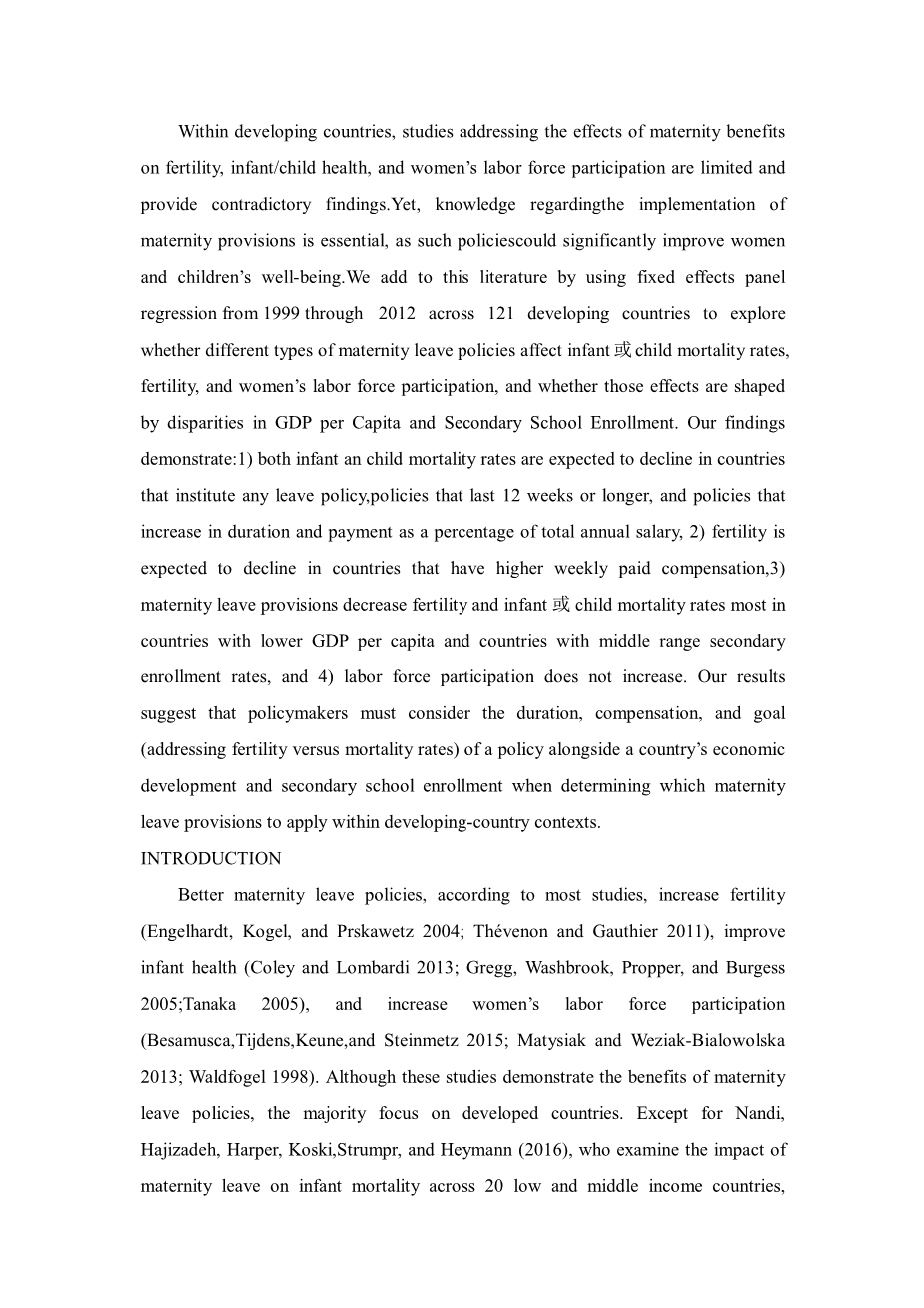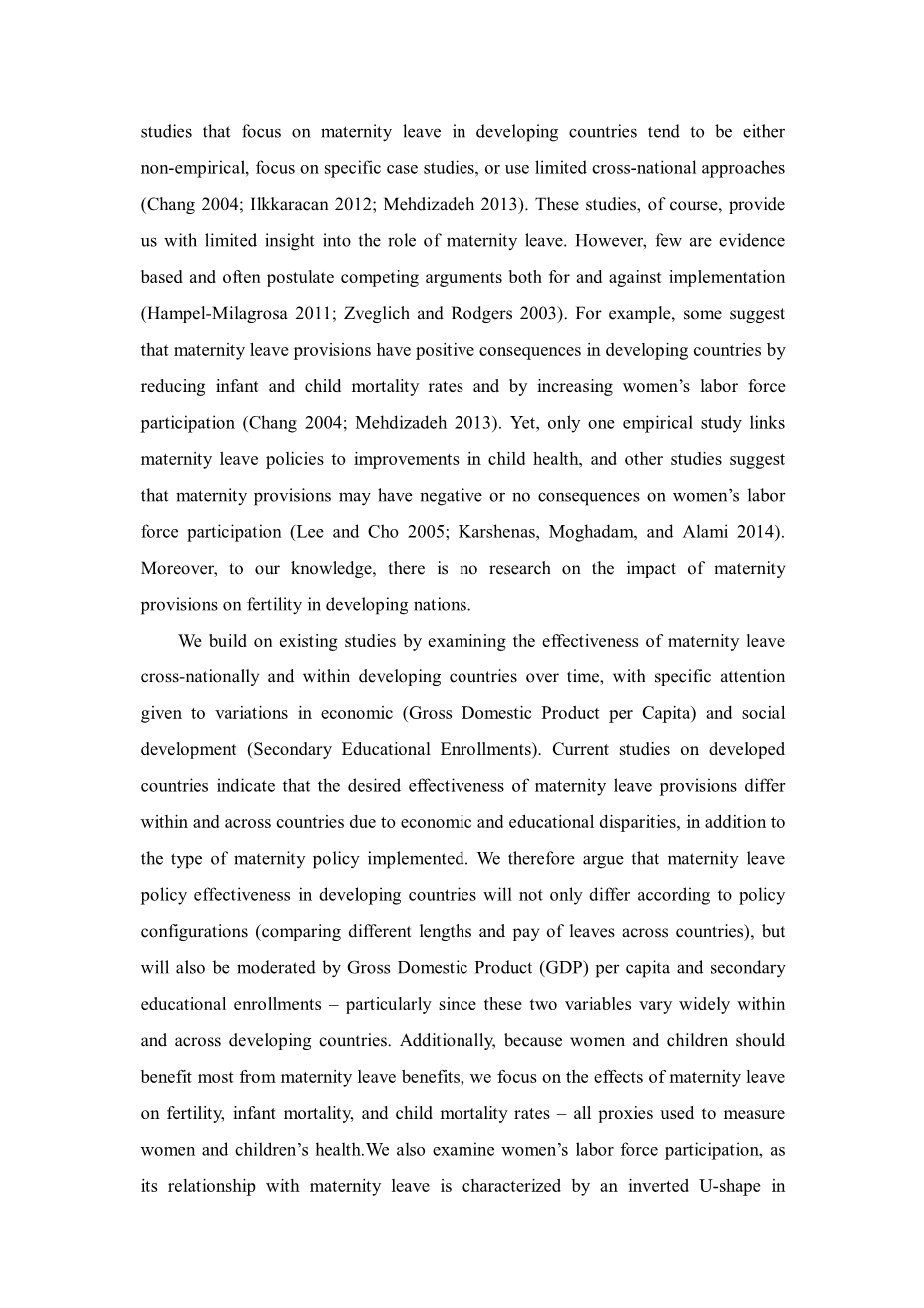

英语原文共 4 页,剩余内容已隐藏,支付完成后下载完整资料
附录A 译文
产假的发展效益
在发展中国家,解决产妇福利对生育率,婴儿或儿童健康和妇女劳动力参与影响的研究是有限的,并提供了相互矛盾的结果。但是,有关实施产妇规定的知识是必不可少的,因为这些政策可以显著改善妇女和儿童的福祉。我们通过在121个发展中国家使用1999年至2012年的固定效应小组回归来增加这一文献,以探讨不同类型的产假政策是否影响婴儿或儿童死亡率,生育率和妇女劳动力参与,以及这些影响是否由人均国内生产总值和中学入学率的差异。我们的研究结果表明:(1)在制定任何休假政策的国家,持续12周或更长时间的政策以及持续时间和支付额增加的政策占年薪总额的百分比,预计婴儿的儿童死亡率均会下降。(2)在每周支付薪酬较高的国家,生育率预计会下降。(3)产假规定会降低生育率,婴儿或儿童死亡率在人均国内生产总值较低的国家和中等中学入学率的国家中最为明显。(4)劳动力参与没有增加。我们的研究结果表明,政策制定者在确定哪些产假条款适用于发展中国家的情况时,必须考虑政策的持续时间,补偿和目标(解决生育率与死亡率)以及国家经济发展和中学入学率。
介绍
根据大多数研究,更好的产假政策可以提高生育率,改善婴儿健康,并增加女性的劳动力参与率。虽然这些研究证明了产假政策的好处,但大多数都集中在发达国家。除了南迪、哈吉扎德、赫普、考斯基、斯川普和贺曼,他们研究了20个低收入和中等收入国家的产假对婴儿死亡率的影响,关注发展中国家产假的研究往往没经验,关注具体的案例研究,或使用有限的跨国方法。当然,这些研究为我们提供了对产假作用的有限见解。然而很少是证据基础的,并且经常假定支持和反对实施的竞争论点。例如,一些人认为,通过降低婴儿和儿童死亡率以及增加妇女的劳动力参与率,产假规定对发展中国家产生了积极影响。但是只有一项实证研究将产假政策与改善儿童健康联系起来,其他研究表明,产妇条款可能对妇女的劳动力参与产生负面影响或没有影响。此外,据我们所知,没有关于产妇规定对发展中国家生育率的影响的研究。
我们在现有研究的基础上,通过检查跨国界和发展中国家的产假效率,特别关注经济(人均国内生产总值)和社会发展(中等教育入学)的差异。 目前对发达国家的研究表明,除了实施的产妇政策类型之外,由于经济和教育方面的差异,产假规定的效果在国家内部和国家之间有所不同。因此,我们认为发展中国家的产假政策有效性不仅会根据政策配置(比较不同国家的不同长度和薪酬)而有所不同,而且还将受到人均国内生产总值(GDP)和中等教育入学率的限制,特别是因为这两个变量在发展中国家内部和之间变化很大。此外,由于妇女和儿童应从产假福利中受益最多,我们关注的是产假对生育率,婴儿死亡率和儿童死亡率的影响,所有的代理都被用于衡量妇女和儿童的健康。我们还审查了妇女的劳动力参与情况。由于其与产假的关系在发达国家呈倒U形,但在发展中国家解决这种关系的研究是有限的和混合的。通过跨国家和纵向观察各国,我们更进一步了解在发展背景下实施产假规定如何有可能改善妇女和儿童的健康和福祉,这一点继续被强调为推进经济发展的核心例如,在联合国可持续发展目标中就是证明。
具体而言,我们使用从1999年到2012年在121个国家内的固定效应小组回归来探讨不同的产假政策如何影响妇女的生育率,婴儿和五岁以下儿童死亡率以及妇女的劳动力参与,注意到国家内部和国家之间社会和经济发展的变化。我们发现,在采用较高的每周带薪产妇补偿时,各国的生育率较低。在制定任何休假政策的国家,持续12周或更长时间的政策,以及持续时间和支付增加的政策占年薪总额的百分比(与生育率相比更快)的婴儿和儿童死亡率均较低。我们同样发现,按照中学入学率和人均国内生产总值水平调整产假规定。例如,当各国人均国内生产总值和中等中学入学率较低时,预测的生育率和婴儿或儿童死亡率会下降。在考虑到产妇补偿时,随着生育补偿的增加,生育率和死亡率在GDP和中学入学率较高的国家也保持稳定。就妇女的劳动力参与而言,与发达国家不同,更好的产假政策不会增加参与。我们的研究结果表明,政策制定者在决定在发展中国家背景下应用哪些产假福利时,必须考虑政策的长度、持续时间和目标(降低生育率或死亡率)以及国家的经济发展和中学入学率。
产假政策
由于大多数关于产假规定有效性的文献往往侧重于发达国家,因此我们首先概述发达国家背景下的文献,以便为发展中国家提供假设。具体而言,这些研究强调了不同的产妇供应配置,以及发达国家内部和之间社会和经济指标的差异如何影响产假政策的有效性。然后我们转向发展中国家的研究,承认该领域的研究很少。最后,我们从这两个文献中得出结论,以理解不同的产妇规定如何促进发展中国家的女性劳动力参与,生育率和婴儿或儿童健康,以及这些结果如何可能通过教育和人均GDP来调节。
——凯瑟琳M福冷《产假的发展效益》P1-5
附录B 外文原文
Within developing countries, studies addressing the effects of maternity benefits on fertility, infant/child health, and womenrsquo;s labor force participation are limited and provide contradictory findings. Yet, knowledge regardingthe implementation of maternity provisions is essential, as such policiescould significantly improve women and childrenrsquo;s well-being.We add to this literature by using fixed effects panel regression from 1999 through 2012 across 121 developing countries to explore whether different types of maternity leave policies affect infant或child mortality rates, fertility, and womenrsquo;s labor force participation, and whether those effects are shaped by disparities in GDP per Capita and Secondary School Enrollment. Our findings demonstrate:1) both infant an child mortality rates are expected to decline in countries that institute any leave policy,policies that last 12 weeks or longer, and policies that increase in duration and payment as a percentage of total annual salary, 2) fertility is expected to decline in countries that have higher weekly paid compensation,3) maternity leave provisions decrease fertility and infant或child mortality rates most in countries with lower GDP per capita and countries with middle range secondary enrollment rates, and 4) labor force participation does not increase. Our results suggest that policymakers must consider the duration, compensation, and goal (addressing fertility versus mortality rates) of a policy alongside a countryrsquo;s economic development and secondary school enrollment when determining which maternity leave provisions to apply within developing-country contexts.
INTRODUCTION
Better maternity leave policies, according to most studies, increase fertility (Engelhardt, Kogel, and Prskawetz 2004; Theacute;venon and Gauthier 2011), improve infant health (Coley and Lombardi 2013; Gregg, Washbrook, Propper, and Burgess 2005;Tanaka 2005), and increase womenrsquo;s labor force participation (Besamusca,Tijdens,Keune,and Steinmetz 2015; Matysiak and Weziak-Bialowolska 2013; Waldfogel 1998). Although these studies demonstrate the benefits of maternity leave policies, the majority focus on developed countries. Except for Nandi, Hajizadeh, Harper, Koski,Strumpr, and Heymann (2016), who examine the impact of maternity leave on infant mortality across 20 low and middle income countries, studies that focus on maternity leave in developing countries tend to be either non-empirical, focus on specific case studies, or use limited cross-national approaches (Chang 2004; Ilkkaracan 2012; Mehdizadeh 2013). These studies, of course, provide us with limited insight into the role of maternity leave. However, few are evidence based and often postulate competing arguments both for and against implementation (Hampel-Milagrosa 2011; Zveglich and Rodgers 2003). For example, some suggest that maternity leave provisions have positive consequences in developing countries by reducing infant and child mortality rates and by increasing womenrsquo;s labor force participation (Chang 2004; Mehdizadeh 2013). Yet, only one empirical study links maternity leave policies to improvements in child health, and other studies suggest that maternity provisions may have negative or no consequences on womenrsquo;s labor force participation (Lee and Cho 2005; Karshenas, Moghadam, and Alami 2014). Moreover, to our knowledge, there is no research on the impact of maternity provisions on fertility in developing nations.
We build on existing studies by examining the effectiveness of maternity leave cross-nationally and within developing countries over time, with specific attention given to variations in economic (Gross Domestic Product per Capita) and social development (Secondary Educational Enrollments). Current studies on developed countries indicate that the de
全文共10204字,剩余内容已隐藏,支付完成后下载完整资料
资料编号:[453522],资料为PDF文档或Word文档,PDF文档可免费转换为Word


